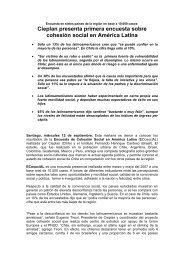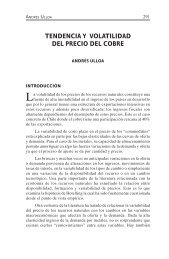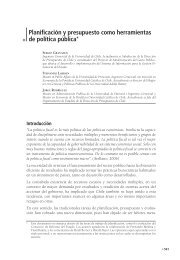Recovery: The Global Financial Crisis and Middle-Income Countries
Recovery: The Global Financial Crisis and Middle-Income Countries
Recovery: The Global Financial Crisis and Middle-Income Countries
You also want an ePaper? Increase the reach of your titles
YUMPU automatically turns print PDFs into web optimized ePapers that Google loves.
6 alej<strong>and</strong>ro foxleyQuestion 2: Is cumulative learning arising from the financial crises ofthe past, or are we witnessing the same mistakes all over again?<strong>The</strong> recent experience of one group of middle- income countries, those inEastern Europe, seems to suggest that we still have a limited capacity to learnfrom other countries’ previous crises.<strong>The</strong> Eastern European countries’ accession to the European Union impliedthat they would open their economies to a huge market <strong>and</strong> to significantcapital inflows, which took the form of foreign direct investment by Europeancompanies <strong>and</strong> of loans, both short <strong>and</strong> long term, from Europeanbanks. Thus, both the governments <strong>and</strong> private sectors of these EasternEuropean nations thought that belonging to the European Union providedimplicit insurance: Continued, uninterrupted access to markets <strong>and</strong> financewas guaranteed by signing the respective treaties of accession. Increasingpublic <strong>and</strong> private spending in the form of a consumption boom did notseem risky at the time.Soon, however, the economies of the new EU member states began to runthe so- called twin deficits: budget deficits <strong>and</strong> significant imbalances inthe current account of the balance of payments. <strong>The</strong>se deficits were largelyfinanced by incurring external debt— particularly in the form of private foreigncurrency loans. This situation evolved to the point that, by 2007, shorttermexternal debt was equivalent to the total foreign exchange reservesheld by these countries’ central banks. <strong>The</strong> twin deficits— plus excessiveshort- term debt, the accumulation of repayments of long- term debt upfront, <strong>and</strong> insufficient foreign reserves— increased the vulnerability of theseeconomies to sudden reductions in the inflow of net capital.<strong>The</strong> indicators that illustrate this as a possible scenario are given in table 2.When compared with other middle- income countries in Latin America <strong>and</strong>East Asia, the Eastern European economies look much more vulnerable. Infact, the Institute of International Finance predicts that, as a consequence,net capital inflows to Eastern Europe will decrease dramatically, from $254billion in 2008 to $30 billion in 2009. Moody’s (2008) shows high ExternalVulnerability Indicators for several countries in the region, including Estonia,Latvia, Hungary, <strong>and</strong> Lithuania.<strong>The</strong> accumulation of these types of imbalances is not a new or unique phenomenonin recent history. Chile’s financial crisis in 1982 included some ofcarnegie endowment for international peace












